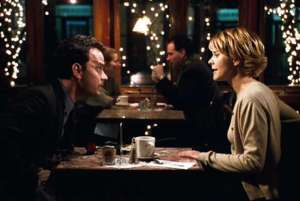Running a bit behind here. It’s been a busy couple of weeks. But at least I’m getting this out in time for Christmas . . .
Countless Christmases
 I believe this is my fourth year of following the Hallmark channels’ gallery of Christmas romance movies (“Countdown to Christmas”). Not that it’s humanly possible to see them all. I believe Hallmark is introducing twenty-three new films this year; and that doesn’t take into account the similar plenitude of programs from the nine previous years of “Countdown.” In this torrent of trysts, it would be easy for the more traditional fare to get lost entirely, from White Christmas to Mr. Magoo’s Christmas Carol (the truly canonical video version of that story, I’m convinced).
I believe this is my fourth year of following the Hallmark channels’ gallery of Christmas romance movies (“Countdown to Christmas”). Not that it’s humanly possible to see them all. I believe Hallmark is introducing twenty-three new films this year; and that doesn’t take into account the similar plenitude of programs from the nine previous years of “Countdown.” In this torrent of trysts, it would be easy for the more traditional fare to get lost entirely, from White Christmas to Mr. Magoo’s Christmas Carol (the truly canonical video version of that story, I’m convinced).
And Hallmark is only the bellwether of an entire subgenre. Netflix has its own array of seasonal video, so similar to the Hallmarks that you’d mistake one for the other if the branding were absent. Subscribe to Amazon Prime instead of Netflix? You can still find plenty of holiday fare, whether traditional flicks or newer Amazon productions.
The trend may be reaching some kind of limit. The plots are starting to recur faster and faster. Of course, that repetition makes these movies ripe for satire. My children pointed me to a Christmas movie script allegedly written by a computer (“Someone Made a Bot Watch 1,000 Hours of Hallmark Christmas Movies and Write a Script”; here’s the original tweet from Keaton Patti). I doubt this was really a bot at work; it’s too funny.
In any case, it turns out these plot generators are spawning as fast as the movies themselves. For example, just at the top of my search results I found samples from WrongHands, E! Online, and The Odyssey Online. Lots of articles remark on the phenomenon. For example, here’s NPR’s snark-fest on the 2019 Christmas romance crop, Hallmark and otherwise.
Among other things, this mass of Christmas cheer does make the field a useful laboratory for looking at some tropes and storytelling points. One could probably do a statistically valid survey with this large a universe of data. Here, I’m just going to focus on one favorite trope: the small business (or, as NPR labels it, the “adorable small business”).
Small Businesses Are Adorable
 Small businesses, especially family businesses, frequently play a role in genre romance movies. For example, in A Christmas Melody (2015), the heroine has just lost her clothing boutique and spends time in a cozy local coffee shop. We also go from one small business to another in The Christmas Ornament (2013), where the heroine has been trying to keep her late husband’s bike shop open, but discovers her real passion is baking cookies (courtesy of a new romantic interest who has a Christmas tree shop). The female lead in The Christmas Secret (2014) has just been fired from her job, but gets a new one in a local bakery. (There are a lot of bakers in these tales. Christmas is cookie season.)
Small businesses, especially family businesses, frequently play a role in genre romance movies. For example, in A Christmas Melody (2015), the heroine has just lost her clothing boutique and spends time in a cozy local coffee shop. We also go from one small business to another in The Christmas Ornament (2013), where the heroine has been trying to keep her late husband’s bike shop open, but discovers her real passion is baking cookies (courtesy of a new romantic interest who has a Christmas tree shop). The female lead in The Christmas Secret (2014) has just been fired from her job, but gets a new one in a local bakery. (There are a lot of bakers in these tales. Christmas is cookie season.)
Sometimes the issue is the temptation to “sell out.” For example, in Let It Snow (2013), the female lead is an executive assigned to overhaul a newly acquired family business, Snow Valley Lodge, into a modernized hipster paradise. She sees the error of her ways, of course.
The trope isn’t confined to Christmas, or to Hallmark. For instance, Coffee Shop (2014) gives us a shop that’s an important gathering place in the community, but financially troubled; her former boyfriend wants to bail her out by selling the property to a mall developer.
The sellout motif reaches a sort of reductio ad absurdum in this year’s Hallmark feature Merry and Bright. Our heroine Cate is doing a good job of running her grandmother’s candy cane company, but candy canes aren’t as big a deal as they used to be. The romantic interest, a “corporate recovery consultant,” proposes gaining a venture capitalist’s support by expanding the business into other Christmasy candy—chocolates and such. That’s such a logical idea that it seemed this story would avoid the trope. But no: as she’s poised to sign the contract, Cate stops and declares that her grandmother founded a candy cane business, nothing else, and Cate’s determined to stick with it.
I sat there open-mouthed (since I had no chocolates to eat, alas) at the notion that manufacturing candy canes was virtuous, but expanding into chocolates was some kind of betrayal. The resolution, in which Cate succeeds by interesting an investor in candy canes with new and innovative flavors, failed to convince me that her scruples made any kind of sense.
A Houston Press article from last year snarks up the trope: “Oh, and every little book store or bakery or community theater can be turned into a resounding success with a little love.”
Variations
On the other hand, we do see some aversions of the trope. A couple of examples from this year’s batch:
In Picture a Perfect Christmas, our heroine is a photographer who travels all around the world for her work. She arrives in a small town for the holidays to look after her aging grandmother, and falls for a local guy. But it’s kind of a relief to find that neither of them has to give up their careers, or found a small business. It appears she can go right on globe-trotting and picture-taking; she’s just going to come home periodically to a new base of operations. In fact, the guy and his semi-adopted nephew are going to join her on her next shoot, in Switzerland, a very sensible plan. It’s kind of refreshing.
The male main character in Christmas Under the Stars is fired abruptly (at Christmas!) from his soulless investment banking job, and ends up working in a little local Christmas tree lot that’s going to be razed for development. He and the female main character save the lot from the bulldozer, as well as solving everyone’s other problems. But the hero doesn’t become a career Christmas tree salesman; he goes back into finance—only this time it’s in a non-soulless company that specializes in ethical investing. So an endearing and Christmasy local business is involved, but it isn’t the ultimate destination of either of the main characters.
The Purpose of a Business
What is it that these cute home-town businesses are supposed to have that makes them so adorable?
We have a widespread sense that a small operation is more likely to have integrity than a larger enterprise: less likely to sell out, more dedicated to its original mission. We tend to feel that a small business will have less discontinuity between its ostensible purposes—making coffee, selling books, offering Christmas trees—and the way it treats people in practice, along with the necessary purpose of making money.
The Incredibles (2004) shows a comically exaggerated version of this divide. Bob Parr works for an insurance company, which is theoretically established to help its customers in times of difficulty. Instead, the institution is so dedicated to denying customer claims that Bob practically has to use guerilla tactics to get a claim honored. For someone with the heart of a superhero—a “helping profession” if there ever was one—this stultifying job is a peculiar kind of hell.
To be sure, a business aims to make money, or it won’t last long. But those who begin it, or join it, generally do so because they aspire to make an excellent product, or provide a useful service. Not many lines of business are pure scams. The trouble is that as the operation gets bigger and older, it seems often to develop a single-minded devotion to making more and more money, even at the expense of the excellence of the product or service. A small enterprise, by contrast, where the owner may come into daily contact with the persons being served, is less likely to be seduced by that particular temptation. It’s easier to keep focus on a product that pleases and benefits people—like cookies.
 An older Christmas movie, It’s A Wonderful Life (1946), lives on that contrast. The quirky and adorable Bailey Building and Loan helps people acquire their own homes, though it’s not as profitable as Mr. Potter’s cruel cost-cutting firm.
An older Christmas movie, It’s A Wonderful Life (1946), lives on that contrast. The quirky and adorable Bailey Building and Loan helps people acquire their own homes, though it’s not as profitable as Mr. Potter’s cruel cost-cutting firm.
This idealization of small firms is easy for the cynic to sneer at. Big business is the way of the world, sloppy sentiment aside. But storytellers are tapping into a genuine issue here.
The Stumbling-Blocks of Largeness
We’re generally told that bigness allows for economies of scale that reduce prices and improve services. To take an example at random, this article by Ken Doctor (12/6/19) states as obvious (even in a critique of mergers) that “McDonald’s can make burgers a lot more efficiently than mom-and-pop joints in every town can.” But this truism needs closer examination.
First, not enough attention is paid to diseconomies of scale. For example, mergers can result in ill-assorted pieces that don’t really work together, offsetting gains that might be achieved by volume discounts. I’m acquainted with one large company, for example, that is still producing separate reports and maintaining separate books for a subsidiary it absorbed at least ten years ago.
A more direct issue with largeness is that as an organization grows, it seem to require more and more generalized policies and inflexible rules. A firm of twenty-five people can make room for individualized exceptions; an organization of ten thousand, not so much. The principle seems to hold true in any kind or organization, whether it’s a private business, a nonprofit, a government, or even a church. Universal rules aren’t all bad; they can be a necessary bulwark against personal discrimination. But as the system grows, we have more and more the sense of dealing with mindless machinery, rather than on a person-to-person basis.
 It seems a company often starts with enthusiasm about a cool product; but as it grows, the bean-counters take over, and that original spark recedes in favor of merely finding ways to pump up the quarterly reports. Google, for example, may (sadly) be in the process of making this transition. The company started out with the innocent motto “Don’t be evil”; it’s now in trouble for helping China with its totalitarian surveillance state via “Project Dragonfly” (though it seems to have backed away from that project as of July). It may be significant that Google’s founders have just departed—perhaps signaling the end of that original enthusiasm for making things better.
It seems a company often starts with enthusiasm about a cool product; but as it grows, the bean-counters take over, and that original spark recedes in favor of merely finding ways to pump up the quarterly reports. Google, for example, may (sadly) be in the process of making this transition. The company started out with the innocent motto “Don’t be evil”; it’s now in trouble for helping China with its totalitarian surveillance state via “Project Dragonfly” (though it seems to have backed away from that project as of July). It may be significant that Google’s founders have just departed—perhaps signaling the end of that original enthusiasm for making things better.
Mergers and Their Discontents
In addition, as a business gets bigger, it tends to crowd out competitors; and an exclusive concentration on increased profits without a corresponding attention to fairness and decency gives rise to a deliberate drive for monopoly, or oligopoly (market power exercised by a few firms rather than only one).
As fewer and larger firms amass market power, the lack of competition results in higher prices, as well as worse customer service. If the combination actually reduces costs, none of the benefits actually flow through to the customer. In my field (telecommunications), I can think of no examples where a merger actually resulted in lower prices for consumers. And it’s hard to think of any where customer service improved as a result; normally, customer service gets worse. For an example from another field, the airlines, consider this aggrieved customer’s horror story.
A less obvious disadvantage is that mergers can result in a loss of institutional memory. A merger frequently seeks to cut costs by dropping redundant staff. Aside from the minor difficulty of people’s losing their jobs (which seems a common anxiety at Christmastime, right back to Scrooge’s threat to Cratchit about “losing your situation”), this means the people who knew the history may be gone. More than once I’ve run into a company that can’t find records of what its own pre-merger components did in the past.
You might say that the legal version of the Hallmark preference for smallness is antitrust law, which is designed to keep large entities from abusing their market power in some of the ways mentioned above. Some contemporary examples of how the antitrust laws are not currently being enforced can be found in a recent article (12/19/19) by Steven Pearlstein.
Bigness is not necessarily bad. But problems such as these are the characteristic flaws of the large organization, against which one must constantly be on guard. In the way that a particular profession may have its “occupational hazards”—say, the temptation of lawyers to fall into a barren legalism—an entity may, simply by its scale, be vulnerable to typical failure modes. The sentimental attachment to small entities is not simply nostalgia; there’s something to it.
The Appeal of the Small Business
We know some of the disadvantages of the small business: for instance, the local shops in the Hallmark romances are frequently on the verge of failing—reflecting, along with the narrative demand of drama, their more limited resources and hence vulnerability to problems, such as a business downturn. But what are the advantages such stories play on?
 Familiarity. The direct contact between businesspeople and customers allows for personal relationships. We see it with George Bailey, making kind-hearted adjustments in payment schedules to help individual customers (a practice for which the hard-charging Potter rakes him over the coals). An older Christmas romance, The Christmas List (1997), apparently not from Hallmark but fitting the mold, features a perfume saleswoman who knows how to figure out the perfect scent for a customer—an unusual sort of personal connection, but a helpful one for the buyer. If I recall correctly, the proprietor in Coffee Shop had a similar talent for determining the perfect drink for someone. You can’t give that kind of personal attention when you’re a faceless cog in a call center working from a fixed script.
Familiarity. The direct contact between businesspeople and customers allows for personal relationships. We see it with George Bailey, making kind-hearted adjustments in payment schedules to help individual customers (a practice for which the hard-charging Potter rakes him over the coals). An older Christmas romance, The Christmas List (1997), apparently not from Hallmark but fitting the mold, features a perfume saleswoman who knows how to figure out the perfect scent for a customer—an unusual sort of personal connection, but a helpful one for the buyer. If I recall correctly, the proprietor in Coffee Shop had a similar talent for determining the perfect drink for someone. You can’t give that kind of personal attention when you’re a faceless cog in a call center working from a fixed script.
To be sure, it’s possible to have this sort of personal relationship in a large organization. A number of the pharmacists at my local CVS, where I show up every couple of weeks for prescriptions, actually know my name. But on the whole, the further away management is from the actual customers, the easier it is for them to regard customers solely in terms of ARPU—“average revenue per unit.”
Community. Thus, there’s a certain warmth and welcome—classic Christmas themes—to the bar “where everybody knows your name.” The local shop can actually engender a close-knit community (the current term seems to be “found family”) capable of mutual support and reassurance. That was a theme in Coffee Shop; it was also at work in another recent non-Christmas romantic comedy, The Bookish Life of Nina Hill (Abbi Waxman, 2019).
 Concreteness. While the intellect has its joys, there’s a particular satisfaction in making something with our hands: a tangible product whose excellence can seen and felt by anyone. The types of small businesses featured in the Christmas romances—bakeries, bookshops, farms—do this a lot. By contrast, a large business often seems to end up dealing in abstractions. Chapter Five of G.K. Chesterton’s Tales of the Long Bow (1924) contrasts the small farmer who actually raises pigs with the wheeler-dealer who merely trades in them. You can read the passage here, though you really need the whole book to fully appreciate the force of Chesterton’s point.
Concreteness. While the intellect has its joys, there’s a particular satisfaction in making something with our hands: a tangible product whose excellence can seen and felt by anyone. The types of small businesses featured in the Christmas romances—bakeries, bookshops, farms—do this a lot. By contrast, a large business often seems to end up dealing in abstractions. Chapter Five of G.K. Chesterton’s Tales of the Long Bow (1924) contrasts the small farmer who actually raises pigs with the wheeler-dealer who merely trades in them. You can read the passage here, though you really need the whole book to fully appreciate the force of Chesterton’s point.
One of the key developments in Pretty Woman (1990) is Edward’s transformation from a soulless transactional businessman to someone who can put his assets and expertise behind what is, in effect, a family business. Initially, his method is to swoop in, acquire a company, split it up and sell off the pieces at a profit—like a stolen car at a “chop shop,” as Vivian pungently observes (see under “Not So Different” at the TV Tropes entry). But he gets to know the father-and-son owners of the current target and their pride in building ships for the Navy. And as Vivian softens his heart, Edward changes his mind: he’s going to support them in building ships for a good cause. He’s going to make something, not just move money around.
Putting ourselves into our work. Along with the pride in building something concrete goes the sense that we’re contributing to the good in the world. The work both expresses oneself and leaves something tangible behind. Small-town construction company owner Jamie Houghton, in Christmas List (Hallmark 2016, not to be confused with “The Christmas List” above), at 1:47, speaks of “…creating something that means something to you—leaving a bit of yourself in the world.” The satisfaction of this kind of work is something the Hallmarks are trying to bring back to our attention. You can put yourself into work for a large organization, too, if the organization allows that much individuality; but it’s harder, for the reasons noted above.
These virtues are so out of fashion that they have an antique feel to us today. That in itself makes them especially useful for a Christmas story. As Hallmark incessantly tells us, Christmas looks backward—to traditions, to memories, to childhood. Ultimately, of course, it looks back two thousand years to the original Christmas.
Small Businesses Help the Plot Thicken
Because of the features we’ve discussed above, the heroine’s bakery or bookshop can serve as a linchpin for the plot. A financial crisis or other threat to the business, or a decision about how what road it’ll take in the future, gives the characters something to be concerned about. How each person responds shows their real character. The heroine’s unsatisfactory current or ex-boyfriend, for example, shows his true colors by endorsing the sellout He has completely failed to understand the heroine, and thus disqualified himself. Or the true romantic interest may take off in a similar big-business direction, leading to tension or a temporary rupture between the main characters; but he can change his mind and thus prove he’s really on her wavelength after all.
There’s an interesting semi-aversion (outside the Hallmark orbit) in You’ve Got Mail (1998). It’s Tom Hanks’ large bookstore that threatens Meg Ryan’s lovable community bookshop, “The Shop Around the Corner.” In the end she loses the bookshop; the economic forces at hand are too great. But as she wanders through Hanks’ larger establishment, she seems to come to terms with it, in a way. The big-box store can also be a place where children encounter beloved books and people can congregate. Maybe if the story had taken place at Christmastime, the ending would have been different . . .
Smallness and Christmas
It’s not exactly a new departure, even in economic circles, to observe that “small is beautiful.” And, as we’ve seen, there are some significant reasons to value smallness and be careful about unlimited growth, even in economic circles. But it makes sense that this motif keeps turning up in stories that appeal to our homelier sentiments too.
It’s also fitting that the trope comes up so frequently in Christmas stories. Christmas, in itself, represents the triumph of the small over the large. One poor couple, without even a home or an inn to have their baby, are ranged against Herod and all his soldiers, and behind them, the Roman Empire. Yet the child has outlasted them all. In the Christmas story we see the divine and universal focused down to an intensely personal scene. Every other small personal triumph can find a home there—even a romance.
At Christmastime, prizing the small may be a cliché – but it’s no accident.
















 Another primarily female archetype is what we might call the Siren, the mysteriously fascinating and unattainable character with whom the male MC is irresistibly obsessed—frequently
Another primarily female archetype is what we might call the Siren, the mysteriously fascinating and unattainable character with whom the male MC is irresistibly obsessed—frequently